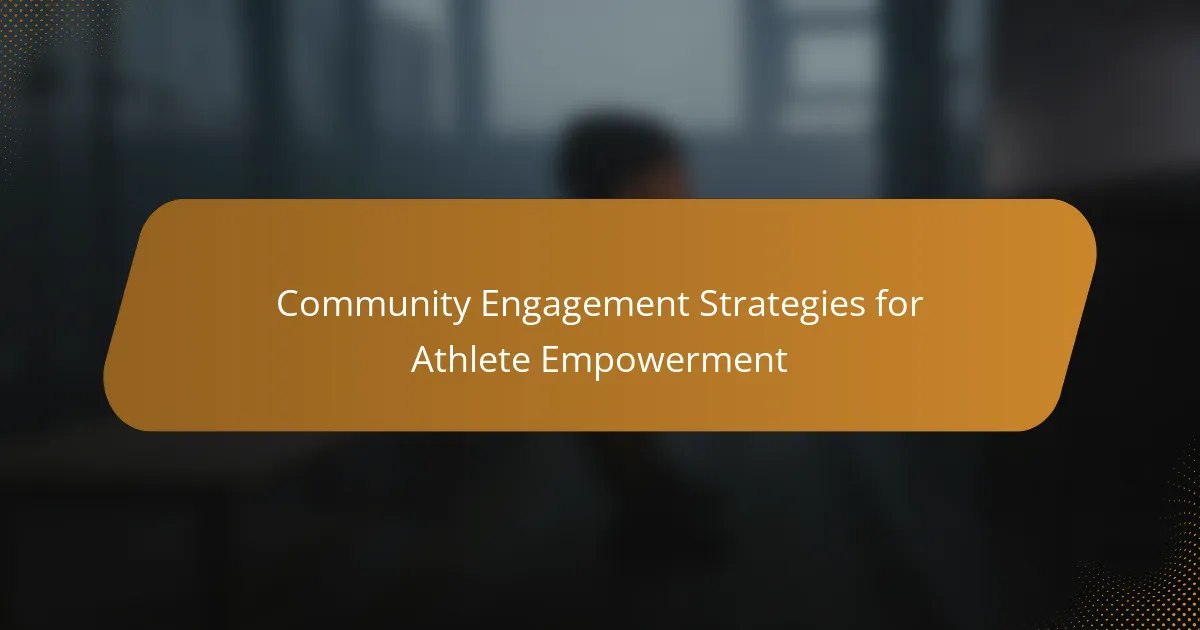Community engagement strategies are essential for empowering athletes and enhancing their development. Key approaches include fostering relationships with local organizations, utilizing social media for connection, and implementing effective feedback mechanisms. Addressing challenges such as resource limitations and cultural barriers is crucial for creating sustainable support systems. Tracking metrics like participation rates and athlete satisfaction can provide valuable insights into the effectiveness of these initiatives.
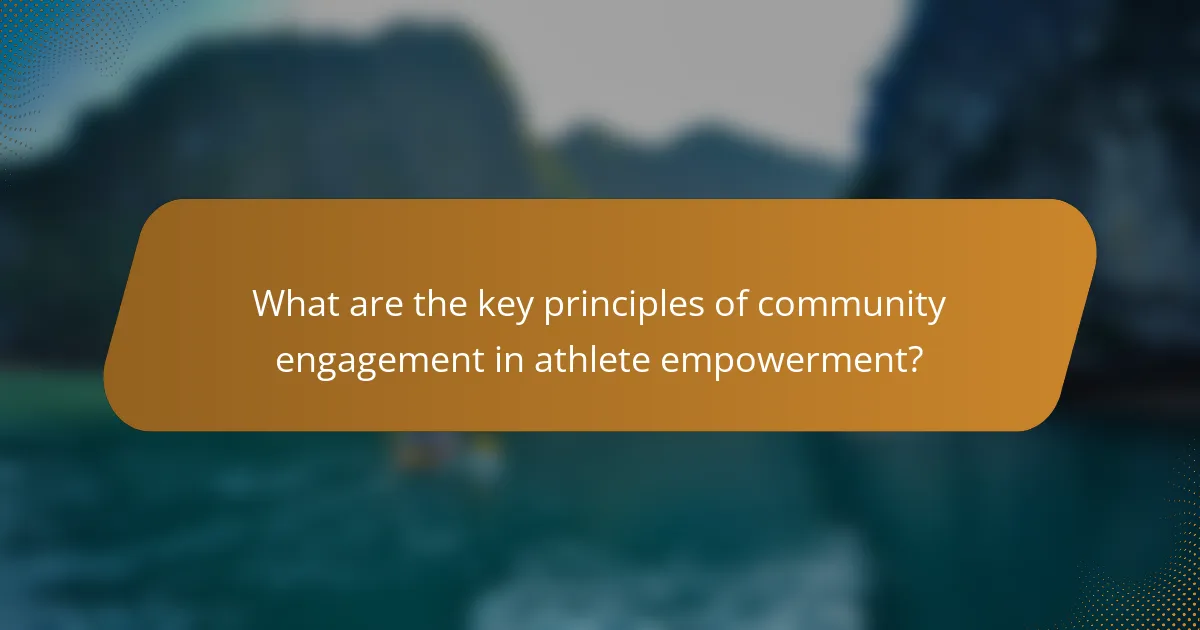
What are the key principles of community engagement in athlete empowerment?
Community engagement in athlete empowerment is rooted in collaboration, inclusivity, and support. Key principles include fostering strong relationships between athletes and communities, encouraging participation in decision-making, and promoting shared goals. Empowerment thrives on active listening, where athlete feedback shapes programs. Additionally, leveraging local resources strengthens community ties, enhancing athlete development and well-being. Engaging diverse audiences ensures representation and broadens support networks, ultimately creating a more sustainable environment for athlete empowerment.
How does effective communication enhance athlete participation?
Effective communication significantly boosts athlete participation by fostering trust and collaboration. It creates a supportive environment where athletes feel valued and understood. Engaging athletes through open dialogue enhances motivation and commitment. As a result, participation rates increase, leading to stronger community ties and improved performance outcomes.
Why is inclusivity crucial in community engagement strategies?
Inclusivity is crucial in community engagement strategies because it fosters diverse participation and enhances athlete empowerment. Engaging varied voices leads to richer perspectives and innovative solutions. Inclusive strategies build trust, promote collaboration, and ensure that all community members feel valued. This approach ultimately strengthens community ties and improves overall outcomes for athletes.
Which models of community engagement are most effective for athletes?
Collaborative partnerships and grassroots initiatives are the most effective community engagement models for athletes. These strategies empower athletes by fostering connections with local organizations and enhancing community support.
Collaborative partnerships involve athletes working with schools, nonprofits, and businesses to create programs that promote health, fitness, and social responsibility. This model encourages mutual benefit, as athletes gain visibility while communities receive support and resources.
Grassroots initiatives focus on localized efforts led by athletes to inspire and mobilize community members. These initiatives often engage youth through sports clinics, mentorship programs, and health awareness campaigns, creating a lasting impact.
Both models leverage athletes’ influence to drive positive change, making community engagement a powerful tool for empowerment.
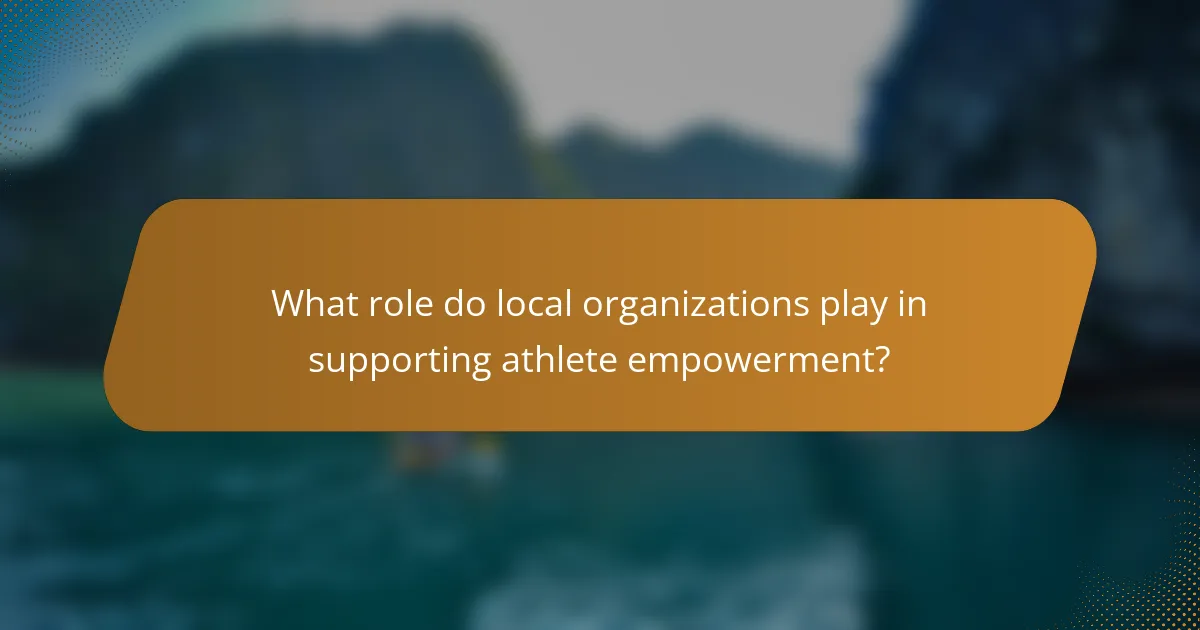
What role do local organizations play in supporting athlete empowerment?
Local organizations play a crucial role in athlete empowerment by providing resources, mentorship, and community support. They facilitate training programs, offer financial assistance, and create networking opportunities. These organizations often advocate for athletes’ rights and promote inclusive environments. Their initiatives can significantly enhance athletes’ confidence and skills, leading to greater success in their sports careers. By fostering a sense of belonging, they empower athletes to pursue their goals more effectively.
How can partnerships with schools foster athlete engagement?
Partnerships with schools can significantly enhance athlete engagement by providing structured programs and resources. These collaborations create opportunities for athletes to participate in workshops, mentorship, and physical training. Schools benefit by promoting healthy lifestyles and fostering community spirit. As a result, athletes gain increased visibility and support, which can lead to improved performance and personal development. Engaging with students through school events also builds a sense of belonging and encourages teamwork.
Which community programs have successfully empowered athletes?
Community programs that successfully empower athletes include initiatives focused on mentorship, skill development, and community support. Programs like the Positive Coaching Alliance enhance athletes’ mental resilience and teamwork skills. The Special Olympics fosters inclusion and confidence among athletes with disabilities. Local youth sports leagues provide access to coaching and resources, promoting physical fitness and social interaction. These programs cultivate a supportive environment that encourages personal growth and athletic excellence.
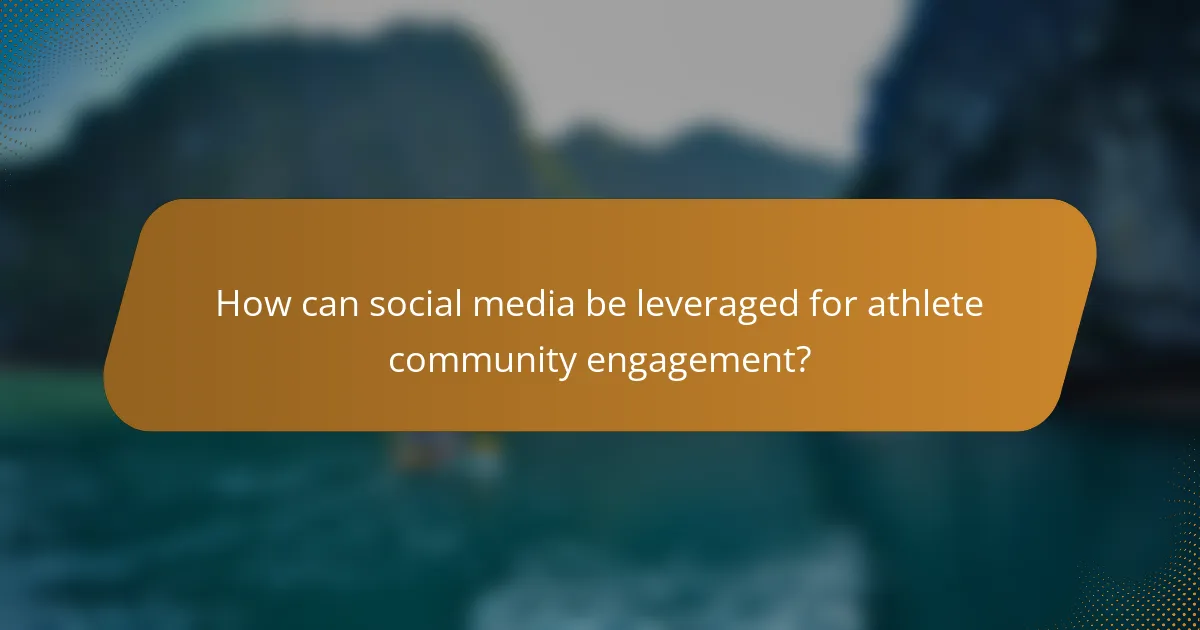
How can social media be leveraged for athlete community engagement?
Social media can enhance athlete community engagement through interactive content, storytelling, and real-time communication. By sharing personal experiences, athletes can foster connections with fans and peers. Engaging followers with polls and Q&A sessions promotes participation. Live streaming events allows athletes to showcase training routines and daily life, building authenticity. Collaborating with brands or other athletes amplifies reach and encourages community discussions. Regular updates and behind-the-scenes content maintain interest and strengthen relationships.
What are the best practices for using social media platforms?
To effectively engage communities on social media, athletes should prioritize authentic interactions, consistent content sharing, and responsive communication. Building trust through transparency fosters deeper connections with fans.
1. Share personal stories to create relatability.
2. Host live Q&A sessions to encourage direct dialogue.
3. Collaborate with other athletes to expand reach.
4. Utilize polls and surveys to involve fans in decision-making.
5. Celebrate community achievements to strengthen bonds.
How do different demographics engage with athlete empowerment online?
Different demographics engage with athlete empowerment online through tailored community strategies. Younger audiences often utilize social media for advocacy, while older demographics may prefer traditional platforms. Engagement varies based on cultural backgrounds, with some groups emphasizing local community support. Gender differences also influence participation, as female athletes often face unique challenges in gaining visibility. Overall, understanding these demographic nuances enhances the effectiveness of empowerment initiatives.
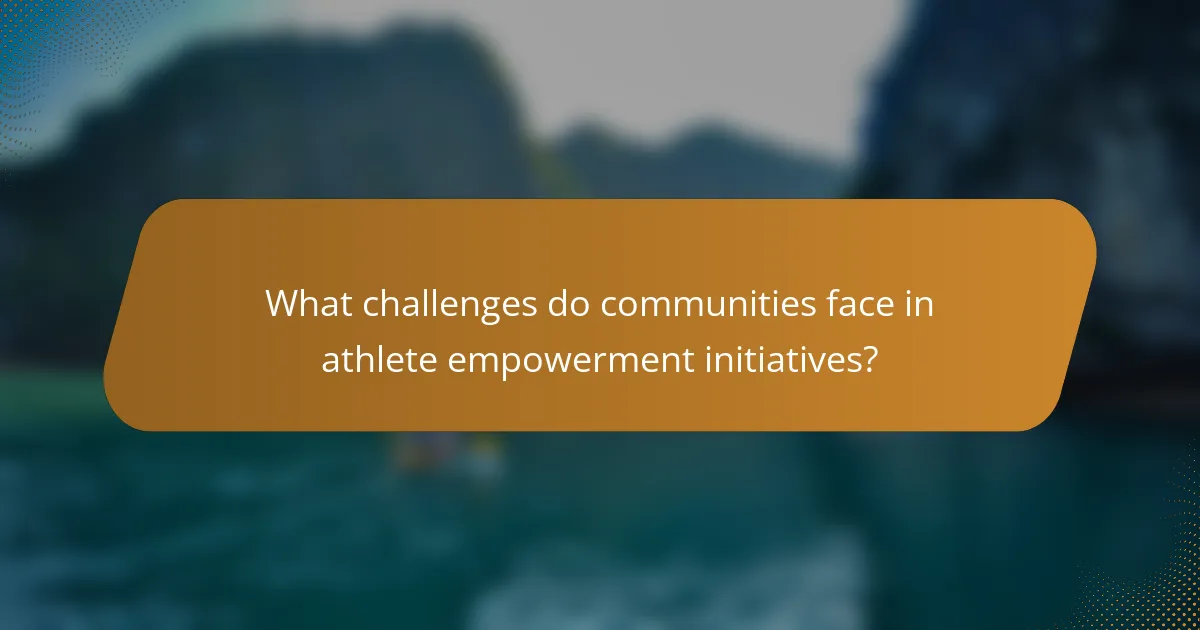
What challenges do communities face in athlete empowerment initiatives?
Communities face several challenges in athlete empowerment initiatives, including resource limitations, lack of engagement, and cultural barriers. Resource limitations often hinder the development of programs that can effectively support athletes. Lack of engagement from stakeholders can lead to insufficient participation and support for initiatives. Cultural barriers may prevent open discussions about athlete empowerment, reducing the effectiveness of programs designed to foster growth and development. Addressing these challenges is crucial for successful community engagement strategies.
Why do some athletes feel disconnected from their communities?
Athletes may feel disconnected from their communities due to limited engagement opportunities and lack of support networks. Community engagement strategies can empower athletes by fostering connections through mentorship, local events, and collaborative initiatives. These strategies enhance athletes’ sense of belonging and promote positive relationships with their communities. Active participation can lead to shared experiences, increasing emotional ties and support systems.
What are common barriers to effective community engagement?
Common barriers to effective community engagement include lack of trust, insufficient resources, and ineffective communication. These factors hinder athlete empowerment and limit participation. Trust issues arise from past experiences or perceived neglect. Resource constraints often include time, funding, and personnel, which restrict outreach efforts. Lastly, unclear messaging can alienate potential participants, reducing engagement opportunities. Addressing these barriers is crucial for successful community engagement in sports.
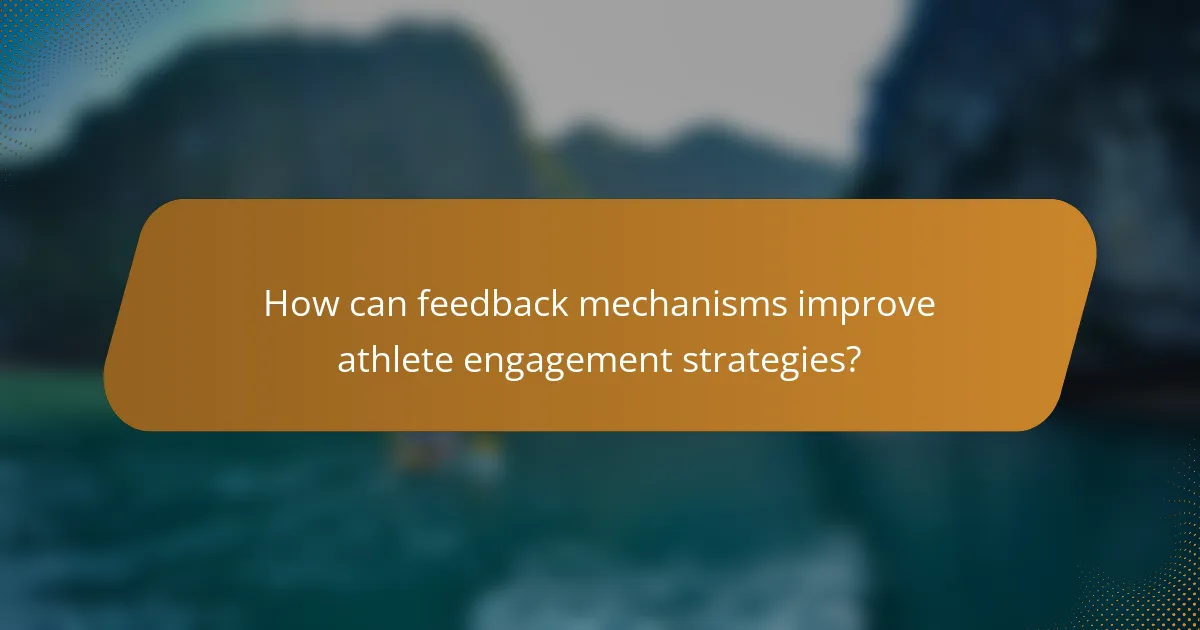
How can feedback mechanisms improve athlete engagement strategies?
Feedback mechanisms significantly enhance athlete engagement strategies by fostering open communication and collaboration. These systems allow athletes to voice their opinions, leading to tailored programs that meet their needs. Engaged athletes demonstrate increased motivation and commitment, resulting in improved performance. For example, regular surveys and feedback sessions can identify areas for development, empowering athletes to take an active role in their training. This participatory approach not only strengthens the athlete-coach relationship but also promotes a sense of community, crucial for long-term success in sports.
What types of feedback are most valuable for community programs?
The most valuable types of feedback for community programs include participant satisfaction surveys, focus group discussions, and outcome assessments. These methods provide insights into program effectiveness and areas for improvement.
Participant satisfaction surveys gauge individual experiences and highlight strengths and weaknesses. Focus group discussions facilitate deeper conversations about community needs and suggestions. Outcome assessments measure the impact of programs on athlete empowerment, ensuring alignment with community goals.
Utilizing these feedback types enhances program relevance and fosters stronger community engagement.
How can community leaders effectively implement athlete feedback?
Community leaders can effectively implement athlete feedback by establishing open communication channels and actively involving athletes in decision-making processes. Engaging athletes fosters a sense of ownership and encourages honest feedback.
Leaders should conduct regular surveys to gather insights on athlete experiences and needs. This data can inform program adjustments and enhance athlete satisfaction. Additionally, creating forums for athletes to share their thoughts promotes transparency and trust within the community.
Training sessions for leaders on how to interpret feedback can improve responsiveness. Understanding common themes in feedback allows leaders to prioritize changes that will have the most significant impact on athlete engagement and performance.
Lastly, recognizing and celebrating athlete contributions reinforces their value in the community. This can include highlighting athlete achievements in newsletters or community events, strengthening the bond between athletes and leaders.
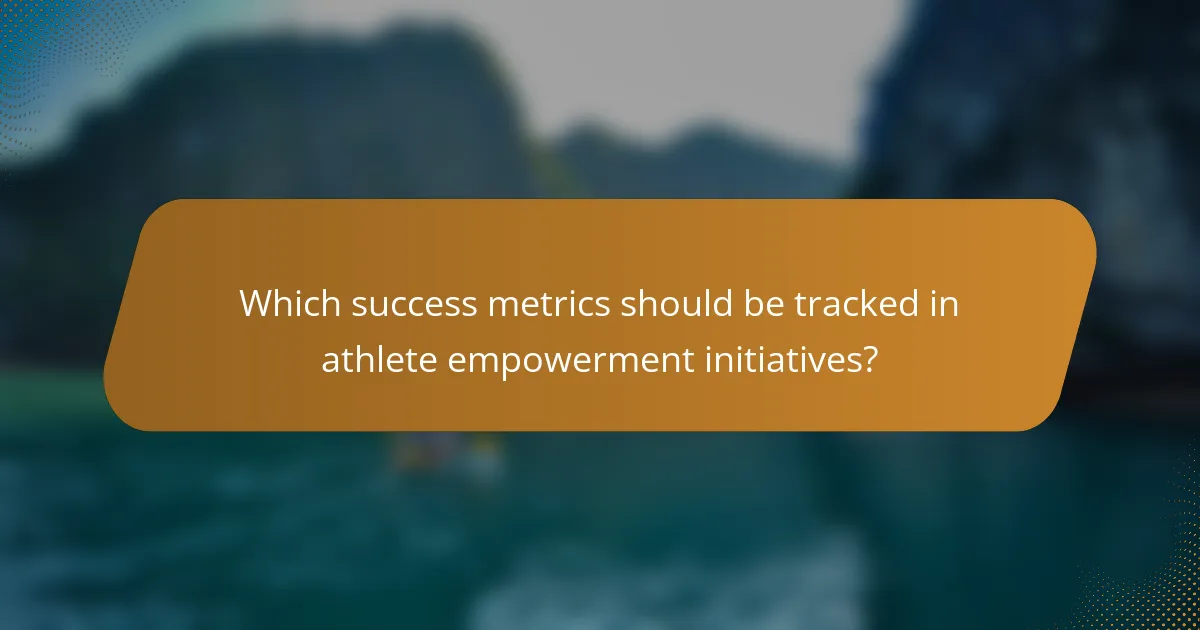
Which success metrics should be tracked in athlete empowerment initiatives?
Track metrics such as participation rates, athlete satisfaction, community outreach impact, skill development progress, and social media engagement. These metrics provide insights into the effectiveness of community engagement strategies in athlete empowerment initiatives.
| Metric | Description |
|—————————-|———————————————-|
| Participation Rates | Measures athlete involvement in programs |
| Athlete Satisfaction | Gauges contentment with empowerment efforts |
| Community Outreach Impact | Assesses reach and influence in the community|
| Skill Development Progress | Evaluates improvement in athletic skills |
| Social Media Engagement | Tracks online interactions and discussions |
How do community engagement metrics differ across regions?
Community engagement metrics vary significantly across regions due to cultural, economic, and social factors. For instance, urban areas often show higher engagement levels through organized sports events, while rural regions may rely on community-led initiatives.
| Region | Engagement Metric | Notable Characteristics |
|—————–|—————————-|—————————————-|
| Urban | High event participation | Access to facilities and resources |
| Suburban | Moderate volunteerism | Family-oriented activities |
| Rural | Community-led initiatives | Strong local networks |
| Developing | Emerging online platforms | Digital engagement growth |
| Affluent | Corporate sponsorships | High funding for athlete programs |
| Low-income | Grassroots movements | Limited resources but high community spirit |
These differences highlight the need for tailored community engagement strategies that empower athletes through localized approaches.
What are the long-term impacts of successful athlete empowerment?
Successful athlete empowerment leads to enhanced community engagement, fostering long-term positive impacts. Empowered athletes often become role models, promoting physical activity and healthy lifestyles within their communities. This influence can increase participation in sports programs and local initiatives.
Moreover, athlete empowerment encourages collaboration between athletes and community organizations. This partnership can result in improved resources for youth programs, increasing access to sports and wellness activities. As a result, communities may experience a decline in youth delinquency and an increase in social cohesion.
Additionally, empowered athletes frequently advocate for social issues, raising awareness and driving change. Their platforms can influence public policy, leading to better funding for sports and recreational facilities. Therefore, the long-term impacts of successful athlete empowerment extend beyond individual athletes, positively transforming entire communities.
What practical tips can enhance community engagement for athlete empowerment?
Incorporating practical tips can significantly enhance community engagement for athlete empowerment. Focus on building relationships, fostering collaboration, and creating inclusive environments.
1. Organize community events to connect athletes with local residents, promoting interaction and shared experiences.
2. Leverage social media platforms to share athlete stories, achievements, and community initiatives, increasing visibility and support.
3. Encourage local businesses to sponsor events, providing resources while strengthening community ties.
4. Create mentorship programs that pair experienced athletes with youth, empowering the next generation and fostering a sense of belonging.
5. Establish feedback mechanisms to understand community needs and adapt programs accordingly, ensuring relevance and engagement.
